INTRODUCTION
The growth of the pharmaceutical industry is considered one of the top flourishing industries in India. It is contributing immensely to the growing economy of India. The industry has grown at a compounded annual growth rate of approximately 13% over the two decades. India’s domestic pharmaceutical market is probably going to succeed at US$65 billion by 2024 and additionally expand to reach ~US$120–130 billion by 2030 (IBEF, 2022). At a similar time, India is turning into a most preferred place for International pharmaceutical corporations because of its low labor cost, highly qualified graduates, and raised infectious disease. India has become a top-three pharmaceutical market due to its progressive growth in 2021 (Balakrishnan et al., 2018; IBEF, 2017). This indicates that the jobs will be available in the pharmaceutical sector and thus the recruitment of employees in the pharmaceutical industry may expand rapidly in the coming years (Balakrishnan et al., 2018).
The pharmaceutical industry in India is a part of skill-intensive industries, such as production and services and it is predicted to contribute over 90% of India’s gross domestic product by 2030 (Indian Pharmaceutical Alliance, 2019). Countries such as Brazil, China, Germany, Switzerland, the UK, Canada, the United States of America, Japan, and South Korea have a skilled workforce between 50% and 97%. However, India’s skilled workforce is less than 5% (Singh, 2016a, 2016b).
In India, pharmacy education requires a substantial change. The number of pharmacy institutes has increased dramatically in recent years. However, most institutes are lack of infrastructure and well-trained staff to educate and impart skills to students to transform them into qualified professionals (Singh, 2016a, 2016b). Pharmacy education is affected by severe backdrops and shortcomings in this world of specialization and globalization. The possibility for pharmacy profession development is huge if we have a tendency to raise our standards in line with International expectations (Dave, 2011; Jishnu et al., 2011). The syllabus followed by most institutes in India does not meet global standards (Arakawa et al., 2020; Jishnu et al., 2011; Lalla, 1999).
The curriculum followed by Indian pharmacy colleges is primarily focused on the traditional needs of an industry, which resulted in the creation of a gap between industry and academia. This is due to industry, and academia has entirely different mindset and goals. Students are not exposed to lot of practical expertise. Some of the drawbacks of the current system are the unfocused method of learning, unrevised syllabus, and lack of industrial exposure. The results of research performed in institutional labs and practical training in institutions of India rarely lead to marketing and revenue generation (Lalla, 1999; Seth, 1999; Shaji and Chadawar, 2022). The difference between the skills acquired in institutions and skills required by industry have led to a gap between industry and academia (Balakrishnan et al., 2018). This observed in the recent students who graduate in pharmacy are lack of the appropriate professional skills to meet the industry needs.
A study conducted in both public and private universities in Malaysia offers relevant insights into the desired future job career chosen by pharmacy graduates, the variables influencing their decisions, and their anticipated beginning salarie (Gaut et al., 2021). Fresh pharmacy graduates are not ready for careers in the industry as per their requirements, which lead to increased unemployment among the skilled youth population (Peddle, 2000). Therefore, it was a significant concern and indicated three potential reasons; a) Mismatch between demand and supply, b) Mismatch in expectations, and c) Mismatch in skills. The shortage of appropriate skills and higher dropout rates has a vast effect on India’s ability to acquire new technologies and solutions. Therefore, a fundamental shift toward stress on basic skills in education seems to be necessary because the most required demanded skills are least available (Evers et al., 1998).
Nowadays, employers in each industrial sector emphasize the need for employees with specific core skills. This includes a robust academic foundation besides individual skills like teamwork, problem-solving, work ethic, and integrity. Employability refers to skills and attributes that make an individual desirable to be an expected employee. Employability skills will be outlined as various skills or competencies that will be developed throughout education, training, work experience, interests, and extra-curricular activities that may be generally mentioned as core skills, life skills, basic skills, essential work skills, key competencies, or transferable skills include the capability to resolve the complex multidisciplinary problems, work successfully as teams, demonstrate effective oral and written communication skills, and practice good interpersonal skills (Awandekar et al., 2016).
The problem faced by India at present is an extreme shortage of highly trained skilled workers. We have unemployment in majority of educated people. Nowadays, recruiters expect students with high professional skills for employment so that they are ready to create an instantaneous contribution to the company. Therefore, this study was conducted to assess the knowledge of pharmacy students about the job skills required by the pharmaceutical industry
METHODOLOGY
Study design
A cross-sectional study was conducted among final-year Bachelor of Pharmacy students at eight colleges in South Karnataka. The pharmacy students who were in their final year of graduation and without any backlogs were included in the study. The sampling method was a cluster random sampling technique. The study was conducted using a validated questionnaire. The confidentiality of the respondents was maintained. A participant information sheet has been provided to all students who were willing to participate in the study. An informed consent form was obtained from all participating students prior to the completion of the questionnaire. The students who participated through Google forms got access after obtaining their consent.
The questionnaire was developed from various literature reviews like scientific journals, reviews, and books. The questionnaire consists of 11 open-ended questions covering various core skills and professional skills required for pharmacy students in job roles. A draft was provided to industry experts for validation, and feedback was obtained. The validated questionnaire was distributed to pharmacy students.
Data analysis
The sample size was calculated using prevalence and proportion-based formulae [prevalence 30%, 95% confidence intervals (CIs), and design effect 1.5 was considered]. The required final sample used for the study was 484. The data obtained have been tabulated and analyzed for descriptive statistics of respondents. The comprehensive knowledge was measured from the participants based on summarizing the correct answers for all the questionnaire items. Based on the scores obtained by the students, the knowledge possessed by the students was calculated. A score of 8–12 considered as good, while a score of 5–7 was considered average. A score of 0–4 was considered poor.
RESULTS
The mean age of the respondents was 21 with a standard deviation of 0.77. However, nearly three-quarters (68%) of the respondents were 21 years of age. The number of males who participated was 211, whereas the number of females who participated was 266 as represented in Table 1. The responses given by the participants for skill-based questions were shown in Figure 1.
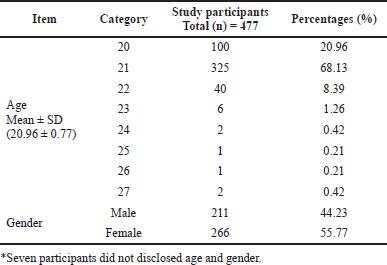 | Table 1. Demographical distribution of the study population. [Click here to view] |
Out of the total students, 462 students have poor skills as their scores lie in the range of 0–4 and 22 students have average skills as their score lies in the range of 5–7. None of the students has good skills. The marks obtained by the students from all colleges are represented in Figure 2. The median score was 2.0. The majority of students have got fewer marks. A very few students got more than 50%. The response of male and female students was represented in Figure 3.
The questionnaire consists of core skills and professional skills required by the students—question numbers 1, 3, 9, and 10 cover problem-solving skill, while question numbers 2, 4, and 8 cover analytical thinking skill. Question numbers 5 and 7 cover critical thinking skills, while question numbers 6 and 11 cover decision-making and communication skills, respectively. The response of students for various skill domains as per college was given in Table 2.
Cumulative percentages of responses obtained for various skill domains were represented using Pareto charts in Figure 4. Problem-solving and analytical skills have more wrong responses compared to other skill domains. Critical thinking skills have more correct responses compared to other skill domains.
One proportion test was done for all the questions using MedCalc statistical software for responses, and the z-statistic, p-value, and 95% CI were shown in Table 3. The knowledge of students is less than 50%. The CI is low for the correct response and high for the wrong response for all the questions.
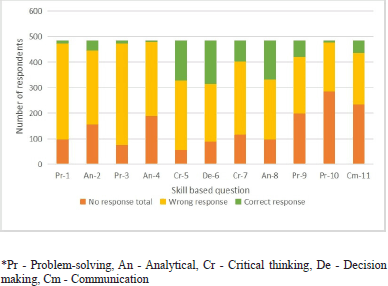 | Figure 1. Total number of responses [Click here to view] |
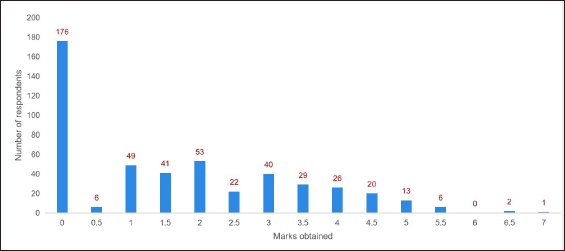 | Figure 2. Respondent score of skill-based questions. [Click here to view] |
DISCUSSION
The study assessed the knowledge of Final year pharmacy students on core skills and professional skills required for job roles such as production chemist and quality assurance chemist in South Karnataka region. Life Sciences Sector Skill Development Council (LSSDC) has started to build a robust and dynamic framework for the development of trained employees that meets internationally recognized standards, which benefits many organizations in the pharmaceutical, biotechnology, and clinical research industries (Singh , 2016a, 2016b). The aim of LSSDC is to find all job roles in this sector and train the unemployed youth in the next ten-year period. Thus it will offer a range of unemployed people with relevant employability in this area. It has identified various job roles in pharmaceutical industries. The Production chemists, Quality control chemists, Quality assurance chemists, and Medical sales representatives constitute the majority of job volume in the pharma sector.
A study has assessed the employability skills among pharmacy students and suggests that theoretical knowledge alone is insufficient for finding a job; students should focus on skills required by industries so that employers can recruit them. Institutes and colleges should encourage students to improve their skills by organizing mock interviews, seminars, workshops, and skill development programs. As there is increased demand for skilled employees in the industry, it is essential to identify the industry needs and collaboration of industry-academia (Awandekar et al., 2016).
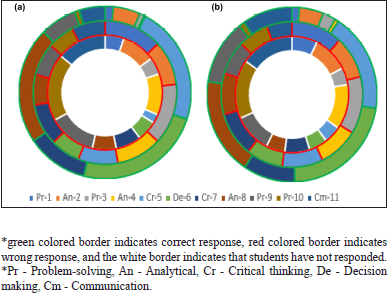 | Figure 3. Response for (a) male (b) female. [Click here to view] |
 | Table 2. Pharmacy student’s knowledge of core skills and professional skills. [Click here to view] |
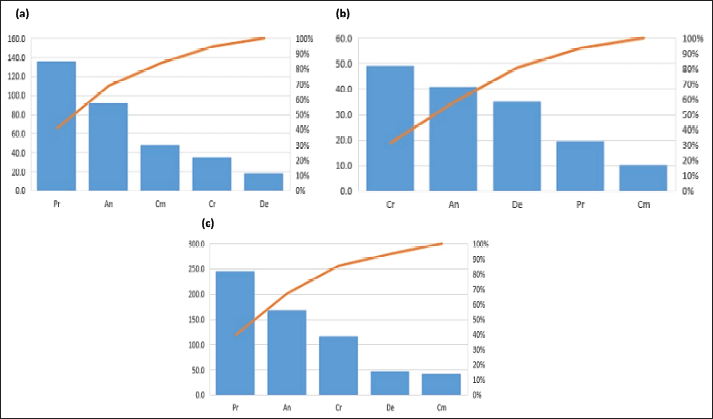 | Figure 4. Pareto chart on responses obtained for various skill domains (a) no response (b) correct response (c) wrong response. [Click here to view] |
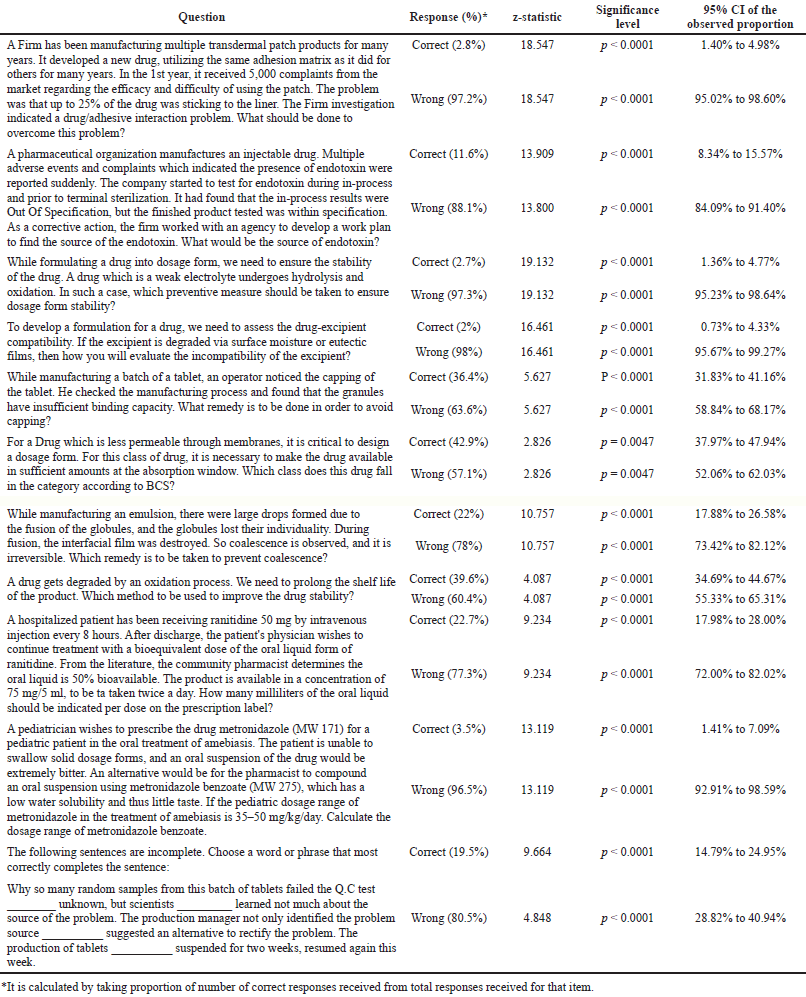 | Table 3. One proportion test for questions. [Click here to view] |
Communication skill is required to communicate in an effective manner. It also helps in understanding documents, writing reports, and listening to the instruction given by in-charges. Communication skill-based question was answered correctly by 10%, 42% answered wrong, and 48% have not responded. As this skill is one most essential skill for the job, it should be focused on by the students.
Analytical skill is an important skill required by students to analyze a dosage form, check for quality, and determine its effectiveness so that it is safe for use. The questions about analytical skills were answered correctly by 14% of students. While, 56% have answered wrong and 30% have not responded to these questions.
Critical thinking is one of the most needed skills of a pharmacy graduate as they must analyze, examine claims, apply judgment, and make a decision (Persky et al., 2019). It is a key cognitive skill that colleges need to improve. It was a significant part of the problem-solving process (Zhou et al., 2013). The question based on critical thinking was answered by 24% of students correctly, 58% gave wrong answers, and 18% did not respond to these questions.
Problem-solving is a fundamental skill that uses acquired knowledge and abilities to attain specific objectives (Persky et al.,2019). The questions related to problem-solving were answered correctly by 5% of students. About 61% have given wrong answers, and 34% have not responded to these questions. This skill is most lacking in students as few answered correctly and most answered incorrectly.
Decision-making is an essential skill in the pharmaceutical industry. It will assess the ability of a person to choose among multiple options. The person has to analyze data to make a decision. About 47% have given the wrong answer to this type of question, while 35% answered correctly. Only 18% have not responded to this question.
The limitation of the study was it covered only few colleges in Karnataka. If the study covers entire Karnataka, we would have got more idea regarding the job skills possessed by students. There would be respondent bias while answering the questionnaire. This study was not extended to understand the knowledge and skill between gender and family background.
CONCLUSION
The study conducted among pharmacy students in various colleges indicated that most students have poor skills. The problem-solving and analytical skills were very poor compared to decision-making, communication, and critical thinking skills. Though decision-making, communication, and critical thinking skills are better in the participants, due to lack of problem-solving and analytical skills it is impacting the overall knowledge and skill in the study population. The study also specifies the need to improve job skills among pharmacy students. It was also noted that there is urgent need to improve the professional skills among students so they will be job-ready in this competitive world. The study also suggests the need to upgrade the pharmacy curriculum as per industry needs or to incorporate training modules as part of the syllabus and bridge the gap between academia and industry.
ACKNOWLEDGMENT
We acknowledge the support of Manipal Academy of Higher Education and Manipal College of Pharmaceutical Sciences throughout the study.
LIST OF ABBREVIATIONS
An: Analytical; CI: Confidence interval; Cm: Communication; CR: Correct response; Cr: Critical thinking; De: Decision making; NR: No response; Pr: Problem-solving; Q: Question; SD: Standard deviation; UK: United Kingdom; USA: United States of America; US$: United States dollar; WR: Wrong response.
AUTHOR CONTRIBUTIONS
All authors made substantial contributions to conception and design, acquisition of data, or analysis and interpretation of data; took part in drafting the article or revising it critically for important intellectual content; agreed to submit to the current journal; gave final approval of the version to be published; and agree to be accountable for all aspects of the work. All the authors are eligible to be an author as per the international committee of medical journal editors (ICMJE) requirements/guidelines.
FINANCIAL SUPPORT
There is no funding to report.
CONFLICT OF INTEREST
The authors declare no conflict of interest.
ETHICAL APPROVALS
The study was approved by Institutional Ethical Committee, Kasturba Medical College, Manipal, and the reference number was IEC 132 – 2019. The study was registered in the clinical trial registry of India (CTRI/2019/07/020338).
DATA AVAILABILITY
All data generated and analyzed are included in this research article.
PUBLISHER’S NOTE
This journal remains neutral with regard to jurisdictional claims in published institutional affiliation.
REFERENCES
Arakawa N, Bruno-Tomé A, Bates I. A global comparison of initial pharmacy education curricula: an exploratory study. Innov Pharm, 2020; 11(1). 1–8. CrossRef
Awandekar NB, Trivedi RV, Umekar MJ. Employability skills assessment amongst pharmacy post graduates in Nagpur region. Int J Pharm Sci Business Manag, 2016; 4(10):1–10.
Balakrishnan A, Thunga G, Sreedharan Vijayanarayana K, Khera K. Bridging the gap between industry and academia in pharmaceutical education. Indian J Pharm Educ Res, 2018; 52(4):S7–10. CrossRef
Dave JB. Does bright future await pharmacy students? Pharma Times, 2011; 43(3):13.
Evers FT, Rush JC, Berdrow I. The bases of competence: skills for lifelong learning and employability. Jossey-Bass Publishers, San Francisco, CA, pp 12 & 16, 1998.
IBEF. Indian pharmaceutical industry. 2022. Available via https://www.ibef.org/industry/pharmaceutical-india.aspx
IBEF. Pharma industry in India: pharma sector overview, market size, analysis. IBEF [Internet]. Ibef org. 2017. Available via https://www.ibef.org/industry/pharmaceutical-india.aspx (Accessed 02 August 2022).
Indian Pharmaceutical Alliance. 2019. Available via https://www.ipa-india.org/media/news-releases/Publications. (Accessed 02 August 2019).
Jishnu V, Gilhotra R, Mishra D. Pharmacy education in India: strategies for a better future. J Young Pharm, 2011; 3(4):334–42. CrossRef
Lalla JK. Pharmacy education—challenges ahead: my perception. Indian J Pharm Educ, 1999; 33:24.
Ooi GS, Ng YP, Choo JY, Balasubramanian GP, Paruchuri S, Low CS, Pillay TS. Future career preferences of final year bachelor of pharmacy students upon graduation from public and private universities in the Northern Region of Malaysia. Syst Rev Pharm, 2021; 12(03):753–60.
Peddle MT. Frustration at the factory: employer perceptions of workforce deficiencies and training trends. J Reg Anal Policy, 2000; 30(1):23–40.
Persky AM, Medina MS, Castleberry AN. Developing critical thinking skills in pharmacy students. Am J Pharm Educ, 2019; 83(2):7033. CrossRef
Singh S. Quality by design in education (QbDE)—a possible futuristic approach to improve current status of pharmaceutical education in India. Indian J Pharm Educ Res, 2016a; 50(1):39–45. CrossRef
Singh S. Skill development and pharmaceutical education. APTI Bull, 2016b; 17(102):8–17.
Seth PD. Pharma education in the new millennium. Indian J Pharm Educ, 1999; 33:93.
Shaji J, Chadawar V. Pharmacy education: it’s challenges. Pharminfo.net., 2022. Available via http://www.pharmainfo.net (Accessed 02 August 2022).
Zhou Q, Huang Q, Tian H. Developing students’ critical thinking skills by task-based learning in chemistry experiment teaching. Creative Education, 2013; 4(12A):40–5. CrossRef